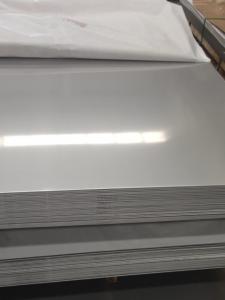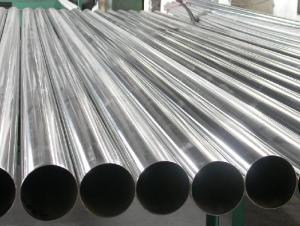Stainless Steel Coil Cold rolled Stainless Steel Coil
- Loading Port:
- Shanghai
- Payment Terms:
- TT OR LC
- Min Order Qty:
- 2 m.t.
- Supply Capability:
- 20000 m.t./month
OKorder Service Pledge
OKorder Financial Service
You Might Also Like
Specification
2205 2507 2520 duplex stainless steel plate
Cold rolled Stainless Steel Coil
Commodity:Cold Rolled Stainless Steel Sheet
Standard:AISI, ASTM, JIS, SUS,GB
Material:304 304L 316 316L 309S 310 201 202
Surface:2B, BA, 8K
Width:1000mm-2000mm as request
Thickness:0.3mm-3mm
Length:1000mm-6000mm as request
Package:Seaworthy wooden pallet or according to client's requirement
Delivery Time:Within 10 days after receive the deposit,or as request
Payment Terms:30%T/T as deposit,and 70%T/T after received the copy of B/L
Quality:Our products have passed the ISO inspections.
Application:1.Food industry equipment,Ordinary chemical equipment,building
2.householdeffects,dinnerware,cupboard,water heater,bathtub
Product Description
Product Name | Mill test certificate 2205 2507 2520 duplex stainless steel plate |
Material | stainless steel |
Color | natural color or as require |
Standard | AISI ASTM JIS SUS and GB |
Grade | 201/304/304L/321/316/316L/309/309S/310S/904L/2205/2507/2520 |
Packing | Seaworthy wooden pallet or according to client's requirement |
Thickness tolerance | +/- 0.25% |
Delivery time | Within 7-15days after getting your deposit. |
Advantages | Strong corrosion and decorative effect |
Mill | TISCO, ZPSS, BAO STEEL, POSCO ,LZ ,etc. |
Products Show
These are the normal items, for the special requirements,we can also meet.
Surface finish | Characteristics and application |
NO.2B | The surface brightness and flatness of no2B is better than no2D. then through a special surface treatment to improve its mechanical properties,No2B could nearly satisfy comprehensive uses. |
NO.3 | Polished with abrasive belt of git#100-#200, have better brightness with discontinuous coarse stria, used as inner and external ornaments for building, electrical appliances and kitchen utensils etc. |
NO.4 | Polished with abrasive belt of grit #150-#180,have better brightness with discontinuous coarse stria,but thinner than No3, are used as bathtub buildings inner and external ornaments electrical appliances kitchen utensils and food processing equipment etc. |
HL | Polished with abrasive belt of grit #150-#320 on the NO.4 finish and has continuous streaks, mainly used as buildings ornaments elevators,door of building, frontal plate etc. |
BA | Cold rolled, bright annealed and skin-passed, the product have excellent brightness and good reflexivity like mirror,kitchen apparatus,ornament etc. |
8K | The product have excellent brightness and prefer reflexivity can to be the mirror. |


Our Advantages
• All products are made of high-quality imported raw materials.
• Our products are certified by ISO9001:2008 authentication quality systems.
• we are nominated as the AAA enterprise by Jiangsu government.
• Quick Response to Your Enquiry.
- Q: Are stainless steel sheets suitable for elevator handrails?
- Yes, stainless steel sheets are suitable for elevator handrails due to their durability, corrosion resistance, and aesthetic appeal. They can withstand frequent use, provide a hygienic surface, and require minimal maintenance, making them an ideal choice for elevator handrails.
- Q: Can stainless steel sheets be used outdoors?
- Indeed, outdoors can accommodate the use of stainless steel sheets. Its exceptional resistance to corrosion renders it an impeccable option for outdoor purposes. The material can endure exposure to moisture, humidity, and even the harshest weather conditions without succumbing to rust or deterioration. Consequently, stainless steel sheets become fitting for an array of outdoor applications, including building facades, roofing, fencing, outdoor furniture, and decorative elements. Furthermore, stainless steel boasts durability, effortless maintenance, and an elegant aesthetic, solidifying its status as a widely favored choice for outdoor utilization in residential, commercial, and industrial environments.
- Q: How do you remove rust from stainless steel sheets?
- To remove rust from stainless steel sheets, you can try using a mixture of baking soda and water to create a paste. Apply the paste to the affected area and gently scrub it with a non-abrasive cloth or sponge. Rinse thoroughly with water and dry the sheets completely. Additionally, you can use white vinegar or lemon juice by applying it directly to the rust spots and letting it sit for a few minutes before scrubbing and rinsing.
- Q: What are the common types of corrosion that affect stainless steel sheets?
- Stainless steel sheets can be affected by various types of corrosion. Pitting corrosion is a common form that occurs when localized areas of the surface are damaged, causing small pits or holes. This corrosion is typically caused by exposure to chlorides, such as saltwater or certain chemicals. Another type is crevice corrosion, which happens in tight spaces or crevices where oxygen and other corrosive agents can become trapped. This can occur in joints between stainless steel sheets or in areas where dirt, debris, or moisture accumulate, creating a favorable environment for corrosion. Galvanic corrosion occurs when stainless steel comes into contact with a different metal in the presence of moisture. The electrical potential difference between the two metals results in the flow of electrical current, leading to corrosion of the stainless steel. Stress corrosion cracking is a type of corrosion that occurs under tensile stress in a corrosive environment. This can cause cracking or fracturing of stainless steel sheets, compromising their structural integrity. Lastly, intergranular corrosion occurs along the grain boundaries of stainless steel. It can result from improper welding practices, exposure to high temperatures, or chemical exposure. Intergranular corrosion weakens the stainless steel sheets and makes them more vulnerable to other forms of corrosion. To ensure the performance and durability of stainless steel sheets, it is important to consider these common types of corrosion. Regular inspections, proper maintenance, and appropriate corrosion prevention measures can help reduce the risk of corrosion and extend the lifespan of the sheets.
- Q: What are the different surface finishes available for stainless steel sheets?
- Some of the different surface finishes available for stainless steel sheets include brushed, mirror, satin, and embossed finishes. These finishes can provide different aesthetic appearances and textures to suit various applications and design preferences.
- Q: How are stainless steel sheets manufactured?
- Stainless steel sheets go through a complex production process with multiple stages. Initially, raw materials such as iron ore, chromium, and nickel are melted in an electric arc furnace to eliminate impurities and create a molten metal. Next, the molten metal is cast into slabs or billets. These slabs undergo hot rolling, where they are passed through rollers to reduce thickness and increase length. This rolling process also refines the grain structure, resulting in a more uniform steel. After hot rolling, the steel is pickled and annealed to remove any scale or impurities and reduce internal stresses. Pickling involves immersing the steel in acid to remove surface oxide, while annealing is a heat treatment process. Following pickling and annealing, the steel undergoes cold rolling at room temperature to further reduce thickness and improve surface finish. This step also imparts desired mechanical properties to the stainless steel sheets. Once the desired thickness is achieved, the sheets are subjected to various finishing processes. These may include surface treatments like polishing, embossing, or etching to enhance appearance and texture. Additionally, cutting techniques like shearing or laser cutting can be employed to achieve the desired size. Lastly, quality control checks are conducted to ensure the sheets meet required specifications. This involves inspecting dimensions, surface finish, and mechanical properties. Once approved, the sheets are packaged and distributed to industries that utilize stainless steel. In conclusion, the manufacturing process of stainless steel sheets involves melting, casting, hot rolling, pickling, annealing, cold rolling, and finishing. This meticulous process guarantees the production of high-quality sheets with exceptional corrosion resistance, strength, and aesthetic appeal.
- Q: How do you install stainless steel sheets?
- To install stainless steel sheets, you will need a few basic tools and follow these steps: 1. Measure and prepare: Start by measuring the area where you want to install the stainless steel sheets. Ensure that the surface is clean, dry, and free from any dust or debris. If needed, sand down any rough spots or imperfections on the surface. 2. Cut the sheets: Using a metal cutting tool like a circular saw or a jigsaw with a metal cutting blade, cut the stainless steel sheets to the desired size and shape. Make sure to wear safety goggles and gloves while cutting to protect yourself. 3. Apply adhesive: Apply a high-strength construction adhesive to the backside of the stainless steel sheet. Make sure to apply the adhesive evenly, leaving no gaps or air pockets. You can also use a notched trowel to spread the adhesive for better coverage. 4. Position and secure: Carefully place the stainless steel sheet onto the prepared surface, making sure to align it properly. Apply gentle and even pressure to ensure the sheet adheres to the surface. You can use a roller or a clean cloth to press the sheet firmly onto the surface. 5. Secure with screws: If necessary, use stainless steel screws to secure the sheet further. Place the screws along the edges and corners, ensuring they are evenly spaced. Make sure not to overtighten the screws to avoid damaging the sheet. 6. Trim and finish: If any excess stainless steel sheet is hanging over the edges, use a metal cutting tool to trim it down to the desired size. Once trimmed, smooth out any rough edges using a file or sandpaper. You can also use a stainless steel cleaner to remove any smudges or fingerprints and give it a polished finish. Remember to always follow the manufacturer's instructions for the specific stainless steel sheets you are using, as installation methods may vary slightly. Additionally, it is recommended to seek professional assistance if you are unsure or not comfortable with the installation process.
- Q: What is the minimum thickness available for stainless steel sheets?
- The minimum thickness of stainless steel sheets can differ depending on the grade and manufacturer. Nevertheless, typically stainless steel sheets are readily obtainable in thicknesses that span from 0.4mm to 6mm. Certain manufacturers might even offer thinner sheets, like 0.3mm, for particular applications. To ascertain the precise minimum thickness that suits your specific needs, it is crucial to consult with the supplier or manufacturer.
- Q: Are stainless steel sheets suitable for solar panel frames?
- Indeed, solar panel frames can be made from stainless steel sheets. Stainless steel, being both robust and long-lasting, possesses exceptional resistance to corrosion, rendering it highly suitable for outdoor purposes such as solar panel frames. It can endure severe weather conditions, encompassing elevated temperatures, humidity, and UV radiation, without succumbing to rust or corrosion. Moreover, stainless steel exhibits a remarkable strength-to-weight ratio, enabling it to uphold the weight of solar panels while preserving its structural integrity. Its attractive appearance and minimal upkeep demands further contribute to its widespread preference for solar panel frames.
- Q: Are stainless steel sheets suitable for medical applications?
- Yes, stainless steel sheets are suitable for medical applications. Stainless steel is a popular choice in the medical field due to its excellent corrosion resistance, durability, and ease of sterilization. It is commonly used in medical equipment, surgical instruments, implants, and even architectural applications within healthcare facilities. Stainless steel is highly resistant to staining, bacterial growth, and contamination, making it a hygienic and safe material for medical use. Additionally, its strength and low maintenance requirements make it suitable for long-term use in demanding medical environments. Overall, stainless steel sheets meet the stringent requirements of medical applications and are a reliable choice for healthcare professionals.
Send your message to us
Stainless Steel Coil Cold rolled Stainless Steel Coil
- Loading Port:
- Shanghai
- Payment Terms:
- TT OR LC
- Min Order Qty:
- 2 m.t.
- Supply Capability:
- 20000 m.t./month
OKorder Service Pledge
OKorder Financial Service
Similar products
Hot products
Hot Searches
Related keywords






























